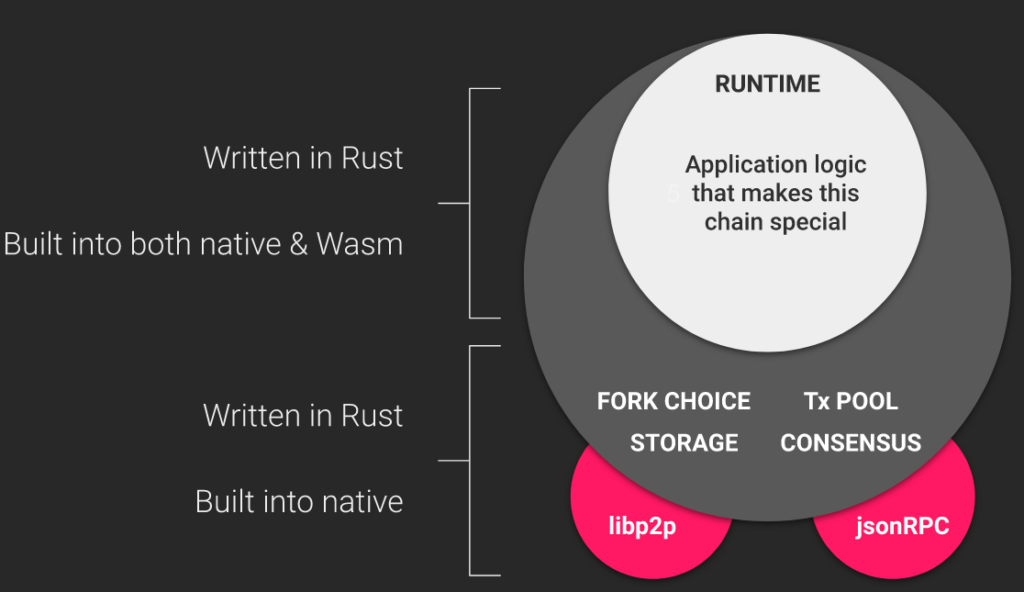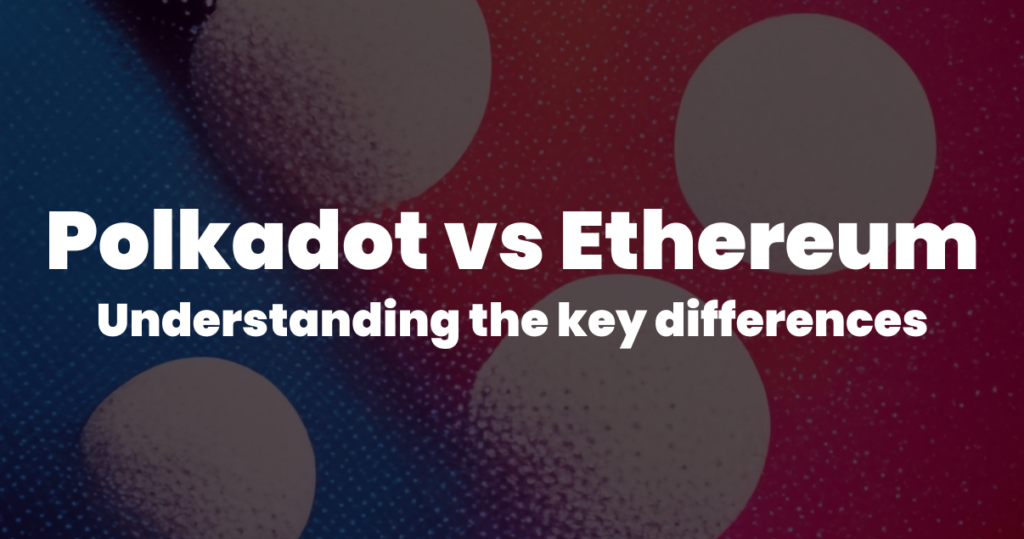Now that Ethereum has joined the Proof of Stake club, it has put forth its initial steps for achieving its ultimate vision of scalability, security, and sustainability. In the PoS club, on the opposite corner, we also have a relatively younger member, Polkadot – The first Layer-0 protocol to connect independent chains together in a single ecosystem.
In this article about Polkadot vs Ethereum, we’re going to dig deeper into how both ecosystems work and differ from each other, looking into their architectures, consensus mechanisms, smart contract languages, and long-term goals.
We’ll, start with an overview of both Ethereum and Polkadot to then compare the different architectures, business logic, and ecosystems.
Ethereum Overview
The flexible ecosystem of Ethereum has extended Blockchain use cases beyond digital currencies and transactions, gradually evolving into a decentralized network able of executing smart contracts, while fostering the creation of new business models like DeFi, DAOs, and protocols.
Over the years Ethereum has grown along with its community while riding the first-mover advantage, and after a successful “The Merge“, shifting the on-chain consensus mechanism from Proof of Work to Proof of Stake, in September 2022, Ethereum laid the groundwork to address its widely criticized inherent challenges:
- Scalability: As of today, Ethereum can process 13-17 transactions per second. Compared to its centralized counterparts like VISA which can process roughly 24,000 Tps or Solana with ~4220tps.
- Gas Fees: Fluctuation in gas fees is undoubtedly the biggest challenge to be addressed. The reason for varying gas fees is the price of ETH and the number of transactions being processed on the network. The slower processing of transactions risks causing network congestion and bottlenecks during peak hours, resulting in driving the Gas fees even higher. This can be prohibitive for users trying to complete smaller transactions.
Ethereum hopes to eradicate its gas fees dilemma after the multi-phase sharding upgrade, which would split the network into smaller pieces called ‘shards’ and increase its throughput and network capacity. With its proclivity towards Layer-2 rollups, Ethereum wants to scale its computational throughput without sacrificing decentralized validation.
Polkadot Overview
Blockchains like Ethereum, are independent and isolated systems operating in their own silos with very little or no interaction with other chains. Such protocol limitations are becoming a hindrance in achieving the true potential of an interoperable and scalable network of blockchains co-existing together. What’s needed, is a way for blockchains, to work together efficiently and securely at scale. This is where Polkadot comes in.
“What we currently have is a patchwork of independent and isolated systems of the Internet. This creates groups who, although share the same vision, they have a misalignment in ways to achieve it. Creating borders where borders are not meant to be there”
– Dr. Gavin Wood (First Polkadot Meetup), Ibiza-2017.
| ETHEREUM | POLKADOT | |
|---|---|---|
| Consensus model | Gasper (CasperFFG, for finality + GHOST, for Block Production) | BABE for block production and GRANDPA for finality |
| Architecture | Single Chain | Heterogeneous sharded chains(Parachains, Parathreads) |
| Governance | Off-chain (present) | On-chain (Technical committee, Council members) |
| Upgrades | Hard fork procedure | Forkless |
| Developability | Smart contracts (Solidity, Vyper) | Substrate framework |
| Smart contracts | Solidity, Vyper, YUL | Ink, rust based or Solidity using EVM pallet |
| Goals | Rollup-centric sharding and Interoperability within the environment, to achieve higher scalability and capacity. | To build an internet of use-case-specific blockchains with true interoperability and transparent governance. |
| Canary Network | None | Kusama |
Polkadot was founded by Dr.Gavin Wood, former CTO of Ethereum and founder of Parity technologies. It is a sharded blockchain Layer-0 Protocol that unites an entire network of diverse blockchains into a single decentralized ecosystem. It makes blockchain scalable and customizable and provides interoperability and cross-chain communication with other blockchains.
Polkadot Architecture:
Polkadot is based upon a sharded peer-to-peer network architecture, which connects several chains in a single ecosystem, allowing them to process transactions parallelly, instead of one at a time as seen in other legacy blockchains like Ethereum (presently). Sharded architecture also makes the exchange of data between chains possible while maintaining enhanced security.
The network of heterogeneous sharded chains Polkadot unites is called ‘parachains’. These chains are connected to and managed by the Relay chain. The parachains can also connect with external networks like Ethereum and Bitcoin via bridges or natively in the case of other WebAssembly based chains.
The Relay Chain: is the central chain of the Polkadot network. It is also known as the heart of the network and, is responsible for coordinating the parachains connected to it. To keep it functionally generalized the relay chain does not support smart contracts. The functionality to house the smart contracts is passed to the parachains instead. The Relay chain is responsible for managing the parachain auctions, on-chain governance, votes mechanism, and the validators. You can call the relay chain the hub of a wheel.
Parachains: are sovereign sharded blockchains connected to the relay chain. They can have their tokens, consensus mechanism, and functionalities that are optimized for specific use cases. Polkadot places no constraints over what parachains can do besides that they must be able to generate proof that can be validated by the validators assigned to that parachain. Consider the parachains as the spokes of the wheel connected to the central hub. The slots for parachains are limited to 100. This means that to connect to the Polkadot network a parachain must win a parachain slot auction.
You can read more about what Polkadot parachain auctions are in this article.
To sum up :
- Polkadot is based upon a heterogeneous sharded architecture.
- Multiple blockchains with their specialized logic co-exist together, they are called Parachains.
- Parachains are connected to and secured by the central chain called-The Relay Chain.
- Bridges are special parachains that can connect to and communicate with other networks like Ethereum.
- Parachains support smart contracts.
- The Relay chain supports up to 100 Parachains slots to connect with.
- Parachains can lease a slot by participating in ‘Parachain auctions’.
Building on Polkadot with Substrate framework 🛠️:
Substrate is an open-source, modular, and extensible framework for building blockchains. It can be used to create standalone chains or Polkadot Parachains.
The Substrate framework provides all the essential elements required to build a chain through components so that the user does not need to have the entire expertise of developing a chain from scratch.
These components include:
- Database Layer
- Networking Layer
- Consensus
- Transaction layer
and many more. Each of them is fully customizable and extendable. All you need to do is write your runtime logic(Application specific logic and the State Transition Function).
To help write your own runtime logic, you can make use of ‘pallets’. Pallets are reusable and modifiable individual pieces of logic (modules) that provide specific functionality for your parachain. You can also call them special building blocks which you can mix and match to suit your business logic.
For example, The balances pallet gives you the cryptocurrency logic. So if you want your chain to have native tokens you can use the balance pallet without needing to write your implementation of a token.
Here’s what the architecture of the substrate looks like:

Now let’s deep down and differentiate both of these ecosystems.
Polkadot vs Ethereum Comparison: Consensus Model
Both Polkadot and Ethereum use hybrid PoS-based consensus models consisting of two major protocols for determining the consensus for block production and finality.
For finality, Ethereum uses the CasperFFG protocol as compared to Polkadot which uses the GRANDPA as its finality gadget. And for block production both the chains use slot-based protocols that randomly assign validators to a slot-RandDAO/LMD for Ethereum and BABE for Polkadot.
Ethereum finalizes the blocks according to a measured amount of time called “epochs”. And finalize multiple batches of blocks in one round. On the other hand, GRANDPA (Polkadot’s finality protocol) finalizes batches of blocks based on availability and validity checks that happen as the proposed chain grows.
Ethereum requires a large number of validators per shard to provide a strong validity guarantee, whereas Polkadot provides more guarantees with lesser validators per shard.
Polkadot vs Ethereum Comparison: Upgrades
In legacy blockchains like Ethereum which are extremely community-centric, there’s a risk of a community split if any feature or upgrade in the making is not agreed upon. Resulting in forking the chain. Hence upgrades on Ethereum will follow a hard fork procedure.
Polkadot on another hand can enact upgrades and proposals without the need of creating a fork, with the help of the Wasm meta-Protocol where the State Transition Function lives on the blockchain itself.
Polkadot vs Ethereum Comparison: Governance
Ethereum still practices soft governance (off-chain governance) procedures. Where the majority of power lies within the hands of Ethereum core Devs.
Polkadot uses a unique on-chain governance concept where all DOT holders can propose a change to the protocol or vote on existing proposals. There are various avenues for proposing motions like the On-chain Council and the Technical committee. These proposals finally become referendums whose outcomes can be controlled by the majority of tokens.
Polkadot vs Ethereum Comparison: Cross-chain communication
With the rise in the number of chains with specific use cases, the need for cross-chain communication and interoperability also rises.
Polkadot is the first Layer-0 Protocol that helps Layer-1 blockchains like Ethereum, Bitcoin, and its own parachains to communicate with each other. To achieve this interoperability and cross-chain communication of arbitrary data within L1 chains, Polkadot uses Cross Consensus message passing Format(XCM) to send arbitrary messages to each other.
Ethereum in its current state(without shards) does not support Cross-chain communication. With the upcoming sharding upgrades, shards in Ethereum might have access to each other’s state via their crosslinks and state proofs.
Polkadot vs Ethereum Comparison: Smart contracts
Introduced by Ethereum, Smart contracts can be considered as open APIs. Anyone can interact with them and integrate them into Dapps. For added functionality, they have an ETH balance associated and can be the target of transactions. To write Ethereum smart contracts you can use Solidity and Vyper. Solidity is an Object Oriented, High-level language influenced by C++. Vyper is a pythonic-based programming language that is built specifically for making contracts more secure and easy to audit.
On Polkadot, parachains are also able to support smart contract functionalities thanks to the Substrate framework and its pallets: The Contracts pallet and the EVM pallet.
- Contracts Pallet will let you use Ink- A domain-specific language derived from rust which will enable you to write stable and secure smart contracts. On Polkadot, smart contracts can perform synchronous calling within the same parachain and asynchronously across other parachains.
- EVM Pallet provides the Ethereum Virtual Machine (EVM) execution environment which allows solidity code to run “natively” on any substrate-based blockchain.
Polkadot: Kusama 🐦
Kusma is Polkadot’s canary network. It’s an independent blockchain that mimics most of the design of its cousin Polkadot. Kusama has its independent on-chain governance and real economic value associated with its native tokens – KSM.
The network is an experimental development environment for developers to battle-test their chains and experiment with newer features, before planning to deploy them on Polkadot.
Ethereum on the contrary does not house any Canary Network for rapid innovation and testing. Instead, it has multiple test networks carrying test Eth, having no real-life economic value.
Can Ethereum and Polkadot work together?
Polkadot uses Wasm (Web Assembly) as its compilation target for runtime logic. Ethereum too is working towards transitioning from EVM (Ethereum Virtual Machine) to E-wasm, an Ethereum-flavoured WebAssembly. This creates possibilities for cross-chain communication and interoperability between both of them in the future.
Is Polkadot Better Than Ethereum?
Well, now that we are aware of how both ecosystems have their ethos, with certain shared goals, and the differences between Ethereum and Polkadot. It is important to note that there is very little direct competition in terms of the product they offer.
Polkadot is focused on being a meta protocol, where you can develop your use case-specific blockchain and an ability to connect different blockchains using Substrate. A low-level abstraction than Ethereum, which is more interested in better smart contract execution and transaction optimization. Where anyone can develop and deploy their smart contracts-based applications quickly.
But, we can agree on one thing: Polkadot is quite ahead of Ethereum when it comes to scalability, interoperability with other blockchains, and its ability to ship faster and forkless upgrades. This gives Polkadot an edge over Ethereum in terms of attracting potential projects to build an interoperable and cooperative ecosystem.
So, on which ecosystem would you like to develop your next Moonshot project?










One Response
Excellent Article!
Would love you talking about MOONBEAM $GLMR
It has comparable traits to Ethereum